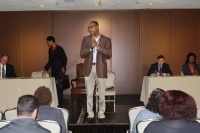One hundred years ago on Oct. 2, 1899, three students attended the first classes taught at The John Marshall Law School. The event realized the hard work of a small group of that era’s most prominent Chicago lawyers and judges, whose vision was to offer a legal education to the working class and immigrants drawn to a flourishing Chicago.
Two of the students were unable to pay tuition. One got permission to sleep at night in the only classroom in the law school, which was then located in the Old Portland Block, a building at the southeast corner of Dearborn Street and Washington Boulevard in Chicago’s Loop.
“Our founders saw a need in 1899,” said John Marshall Law School Dean Robert Gilbert Johnston. “They strongly believed that our legal system should represent all segments of society. To do this, legal education had to be accessible to everyone, regardless of race, religion, ethnic origin or gender,” Johnston explained.
In the mid-1800s, most American attorneys moved up to the job after serving as law clerks or had educated themselves by reading law. By 1900, there was still no state law requiring a law degree, or even a college degree for admission to the bar. In 1850, there were only 15 law schools in the country; but by 1900, the number had risen to 102.
Two factors were spurring public and private universities to establish programs. A legal education was being viewed increasingly as prestigious by the profession. The invention of the typewriter also was shifting the need in law offices for secretaries instead of trainees to hand copy legal documents.
Access to legal education, much like an undergraduate degree, was the province of families or individuals with the means to afford it. John Marshall’s founders wanted to establish a law school that offered opportunities to more than a select few. At John Marshall, students would be able to attend class part-time and work in a law office the rest of the day, combining the “school” and “apprenticeship” methods of legal education.
“Their vision of an open admission policy, combined with a part-time program that could accommodate working men and women and one that relied on practitioners to teach, were the underlying principles on which The John Marshall Law School was created,” Johnston said.
The visionaries included James H. Cartwright, an Illinois Supreme Court judge for more than 25 years; Stephen S. Gregory, president of the Chicago Bar Association (CBA); James S. Harlan, son of the U.S. Supreme Court Justice and an Interstate Commerce Commission member; James G. Jenkins, then a U.S. Appeals Court judge; John N. Jewett, a former CBA president who had declined a U.S. Supreme Court appointment; Edward T. Lee, John Marshall secretary during its first decade and later dean; and Luther Laflin Mills, then Cook County State’s Attorney and a well-known Chicago trial attorney.
The law school held its first commencement in 1902 for a class of 11 students. John Marshall’s first female law student graduated in 1903, and its first African-American law student graduated in 1904.
Today, the law school’s student body exceeds 1,300, with students from 16 foreign countries. Nearly 37 percent continue the 100-year-old tradition of studying law in the evening division. Women comprise 42 percent of its students, and 21 percent are minorities. In 1998, the entering freshman class was 52 percent female, reflecting a recent enrollment trend.
For nearly 65 of its 100 years, John Marshall was led by a member of the Lee family. Edward T. Lee served as secretary from 1899-1909 and dean from 1909-1943. His son, Noble W. Lee, succeeded him in 1944 as dean, serving for 30 years. Both would take on the legal establishment when the legitimacy of part-time legal education programs came under attack.
The legacy of opportunity protected during the law school’s history has produced notable results. More than 250 of John Marshall’s 11,000 alumni serve as judges in local, state and federal courts. Among them are Illinois Supreme Court Chief Justice Charles E. Freeman, the first African-American chief justice in Illinois, and U.S. District Court Judge Blanche M. Manning, who was appointed to the federal bench after serving as the first African-American woman on the Illinois Appellate Court.
More than 60 John Marshall alumni serve as federal, state and local prosecutors, district attorneys and public defenders, and 17 are elected officials and state legislators. They include William M. Daley, U.S. Secretary of Commerce; Lee A. Daniels, Illinois House Minority Leader; and the Hon. David A. Erickson, First Assistant Cook County State’s Attorney.
“John Marshall’s practical skills training and advocacy program prepared me for a career in the courtroom and the public service nature of my training helped me focus my career,” said Erickson, who manages the nation’s second largest prosecutor’s office.
“Large segments of the Cook County State’s Attorney’s Office recruiting classes have come from John Marshall because of its commitment to excellent practical training that gears new attorneys towards public service as well as a career as a trial attorney,” he explained.
“Its history of diversity has enabled us to bring in attorneys with a variety of backgrounds,” Erickson added. “We wish to have an office that serves all of the community just like John Marshall has for 100 years.”
“Our commitment to public service led to the establishment of The John Marshall Fair Housing Legal Clinic in 1992,” Johnston said. One of two such clinics run by law schools in the country, the John Marshall clinic assists local clients who have been discriminated against in housing matters. Supervised by practicing attorneys, John Marshall students prepare motions and participate in federal and state court litigation under fair housing laws.
In 1933, The John Marshall Law School bought the City Club of Chicago’s building at 315 S. Plymouth Ct. While the 1911 craftsmanship of one of Chicago’s top architects, Pond & Pond, has been preserved, the building is joined to the former Rothschild Building at the corner of State Street and Jackson Boulevard, which the law school acquired in 1979. This expansion, coupled with a condominium arrangement for nine floors in the adjacent Chicago Bar Association building at 321 S. Plymouth Ct., has contributed to the revitalization of Chicago’s South Loop and growing reputation as an educational corridor in the city.
“Our Loop location is especially convenient for students,” Johnston said. “They can walk easily to jobs as law clerks in downtown law firms or the federal, state and county courts for judicial clerkships.”
From this urban campus, John Marshall day and evening students today earn a J.D. degree in facilities that include a mock courtroom complex, conference center and the integrated library resources of the Chicago Bar Association and John Marshall. The law school’s expanded curriculum serves practicing attorneys through its respected master’s degree programs that offer LL.M. degrees in comparative legal studies, employee benefits law, information technology law, intellectual property law, international business and trade law, real estate law, and tax law. A master’s degree in information technology law is a recent program addition.
A five-year, $11.5 million fund-raising campaign is now underway to ensure John Marshall is prepared for its next 100 years, William K. Beach, assistant dean for institutional advancement, said. “The campaign is John Marshall’s bridge to its future,” explained Beach. “It will raise funds for much-needed scholarships and financial aid, help to increase our endowment and enable us to expand John Marshall’s academic programs and facilities.”



